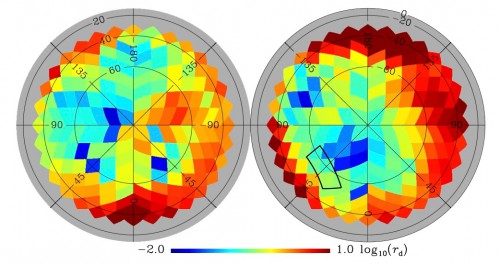
As sometimes happens, the celebrations may have been a bit premature. A new map of interstellar dust in our galaxy has cast doubts on the findings published last March about the discovery of gravitational waves, which would be evidence for left-over radiation signatures from the Big Bang explosion eons ago. It supported the theory that the infant universe went through a period of hyper-accelerated expansion known as inflation.
The much-anticipated paper was just released by the team behind the European Space Agency’s Planck satellite, which mapped the amount of interstellar dust throughout the galaxy.
There was a lot of excitement on March 17 when a team of researchers using the BICEP2 telescope (at the South Pole) announced that they had detected a swirling pattern in the microwave background radiation (the heat left over from the Big Bang). The tiny “twists” were thought to be caused by gravitational waves—undulations in the fabric of space-time created during the earliest moments of the Universe.

As noted by physicist Brian Greene: “The announcement generated worldwide interest because our prevailing theory of cosmology, the inflationary theory, suggests that the rapid swelling of the young universe would have stretched ripples in the fabric of space, creating primordial gravitational waves. The BICEP2 data, some therefore thought, might be the smoking gun evidence for the inflationary theory.”
The BICEP2 results quickly became controversial; some scientists suggested that there might be a more mundane explanation, such as contamination from interstellar dust in the galaxy. It now seems that may indeed be the correct answer. The authors of the new paper argue that the analysis of their data is consistent with the influence of galactic dust and nothing more. It was suggested that the BICEP2 team had “underestimated the role of dust and had incorrectly extrapolated information from preliminary dust maps of the sky compiled from data recorded by Planck.”

It was acknowledged by BICEP2 team leader John Kovac of the Harvard-Smithsonian Center for Astrophysics and his colleagues that ordinary dust in the Milky Way, which can polarize light in the same way that gravitational waves can, may have contaminated the results.
“The level of dust in the BICEP2 region is clearly significant, and also higher than pre-Planck estimates,” said Jamie Bock, a BICEP2 team member at JPL and the California Institute of Technology in Pasadena. “Most of what BICEP2 saw was due to dust,” added David Spergel, a theoretical astrophysicist at Princeton University in New Jersey. He has been one of the most outspoken critics of the original BICEP2 results.
Planck researcher François Bouchet of the Paris Institute of Astrophysics agreed, saying, “It’s most likely that any claim … that a residual signal is due to gravitational waves will be much less significant.”
A disappointing outcome, if verified, but such is the nature of science. It is a simple, but good lesson learned: “You cannot ignore dust,” according to Planck scientist Charles Lawrence of NASA’s Jet Propulsion Laboratory. Cosmic Microwave Background (CMB) experiments in the future will now focus on the least dusty regions of the sky.
It is still possible, however, that BICEP2 did see some evidence of primordial gravitational waves, obscured by the dust impairment, but it will take more work to determine if this is true or not. The BICEP2 and Planck teams intend to collaborate more going forward and produce a more refined analysis this fall. As Spergel noted, there may still be a small residual genuine signal among the dusty noise, “But it’s going to be hard to tease that out.”
The Planck paper and abstract are available here. The new upcoming analysis by the Planck team is due to be released in the new joint paper in late November.
Want to keep up-to-date with all things space? Be sure to “Like” AmericaSpace on Facebook and follow us on Twitter: @AmericaSpace



